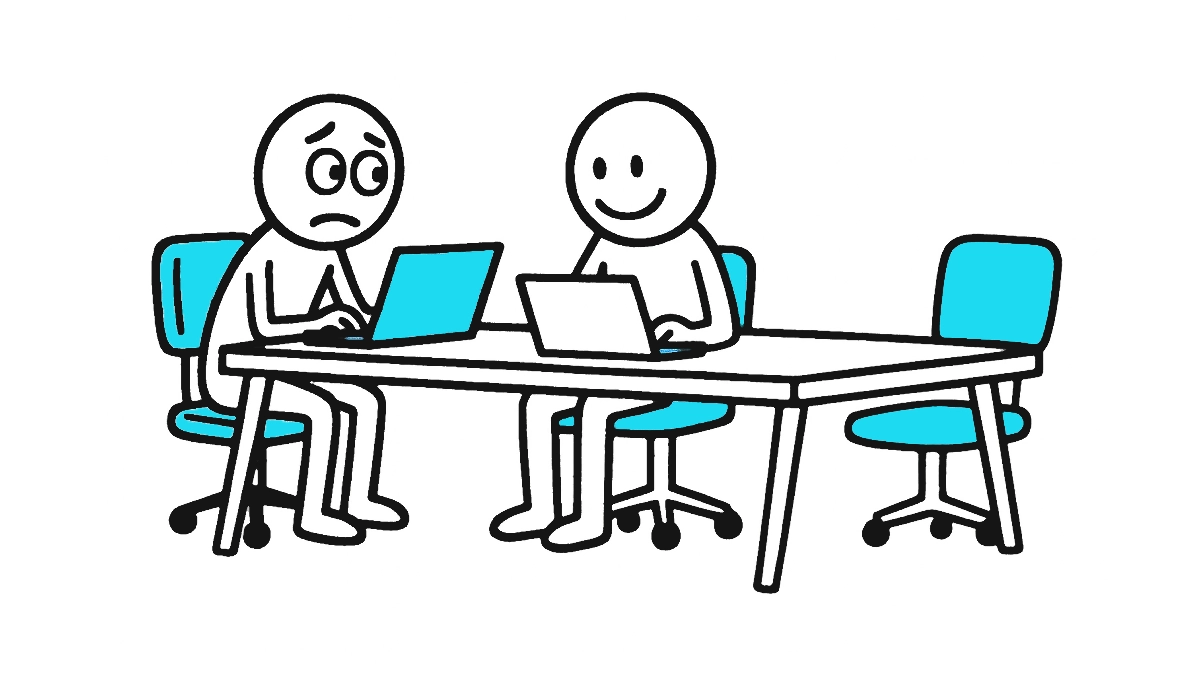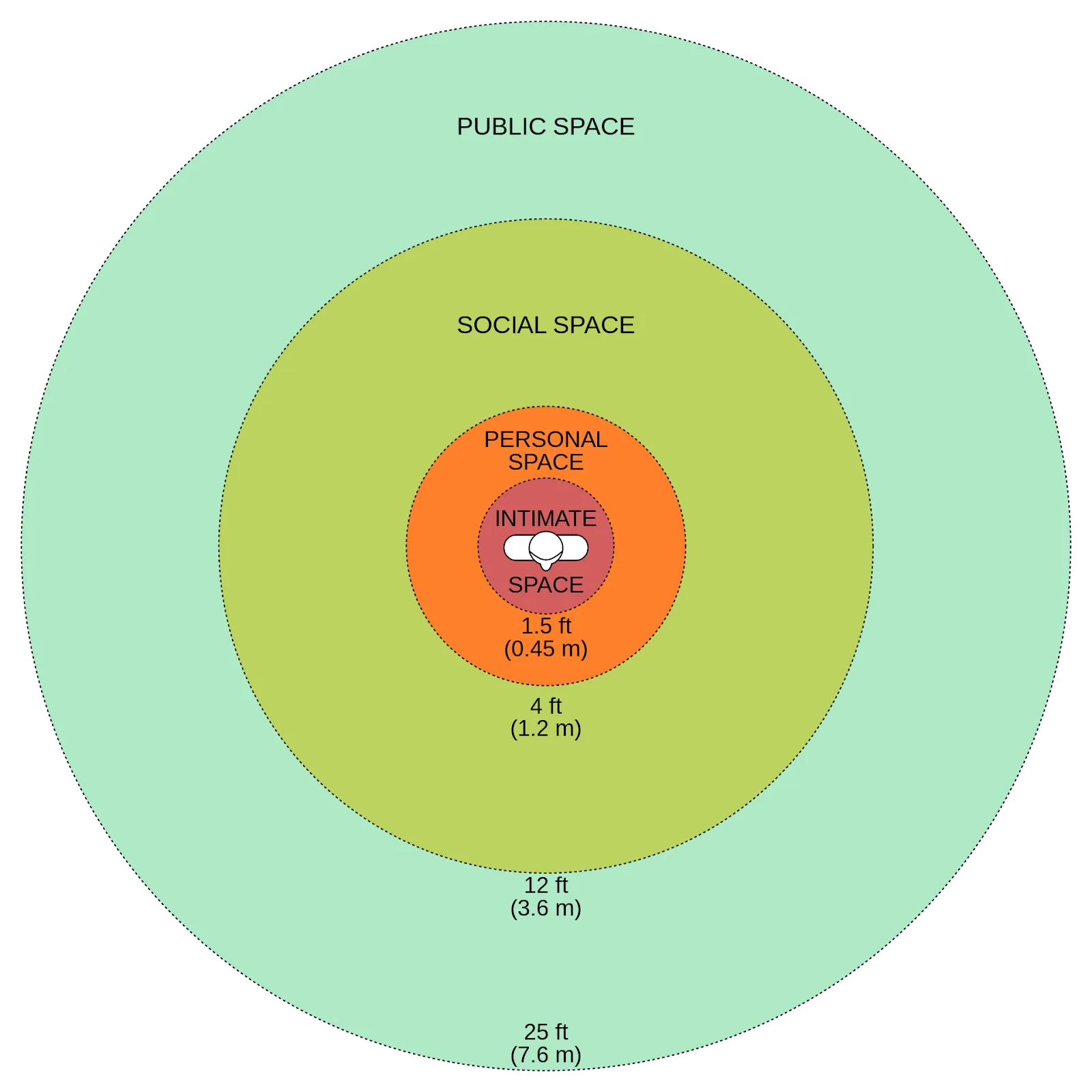Summer Lessons in Personal Space

I'll be speaking at The Science of Meetings this Fall, which reminded me of my WeWork days when we used to talk about the "Science of Space."
Back then, we weren't just designing offices. We studied what brought communities closer together—how culture, layout, and even furniture affect whether workers embrace or avoid connection.
One of my favorite examples was how WeWork adapted its design globally. In China, desk orientations shifted from back-to-back to face-to-face. In LATAM, where group lunches were more common, pantries were larger.
That memory resurfaced recently after a conversation with the CEO of a computer vision company. He described how their tools can measure the physical proximity of people to one another, but also acknowledged that those distances vary dramatically by country.
What's "comfortable" in Tokyo may be uncomfortably close in Toronto.
My favorite term from the “Science of Space” was proxemics—a lens for why workplace experiences feel different across cultures and contexts.
Understanding proxemics could help HR, IT, and RE teams connect better on workplace connection challenges, instead of feeling too far apart.
Lead Across the Lines of Modern Work with Phil Kirschner
Over 22,000 professionals follow my insights on LinkedIn.
Join them and get my best advice straight to your inbox.
Lessons in Getting Closer
My own crash course in proxemics unfolded through four stages—each showing how proximity, in all its forms, changes the way we work.
1) The Power of Collisions (2014)
It started with the HBR article "Workspaces That Move People," in which Ben Waber, Jennifer Magnolfi, and Greg Lindsay showed how small changes in physical proximity—like reconfiguring cafeteria seating—could drive measurable spikes in collaboration and even revenue. Their insight: if you want more innovation, start by designing for more collisions.
2) Propinquity Gets Precise (2017)
Then came Melissa Marsh's exploration of "propinquity"—social or physical nearness that drives meaningful interaction. While proxemics is about how far apart we stand, propinquity is about how those distances translate into actual connection. It added crucial nuance: proximity is necessary, but it's not sufficient for collaboration.
Chapter 3: COVID's Proximity Reset
When the pandemic hit, my former WeWork colleague Ashley Bryan wrote about "Navigating the New Rules of Personal Space." Suddenly, distancing markers and layouts made proxemics visible to everyone. We learned how fragile and culturally contingent our comfort zones really are. This article was also evidence of the pre-pandemic obsession about proxemics across the greatest workplace strategy team there has ever been. 🥰

Chapter 4: Virtual Proximity
Finally, at McKinsey, I co-authored "How Virtual Work Is Accelerating Innovation." The research revealed that proximity isn't only physical—frequent, high-quality virtual interactions can (when managed properly) create similar collaborative energy as sitting side by side.
This evolution explains why proxemics could help cross-functional teams navigate workplace challenges. It's not just anthropology—it's a shared language for multiple teams to engage about how people connect across physical, digital, and cultural boundaries.
🎤 Phil's Upcoming Public Keynotes 🎤
WorkSpaces 2025 | Oct 5-7, Napa Valley, CA
Learn more
Tradeline Space Strategies | Oct 23-24, San Diego, CA
Learn more
The Science of Meetings | Nov 11-13, Ossining, NY
Learn more
Four Types of Workplace Proxemics
There are four flavors of proxemics as it pertains to the improvement of work experience, each tied to distinct insights across functional teams.
1. Cultural Proxemics: Regional Differences
Personal space preferences aren't universal—they're deeply cultural.
Edward T. Hall, the cultural anthropologist who coined the term in 1963, defined proxemics as "the interrelated observations and theories of humans' use of space as a specialized elaboration of culture."
That is, the amount of space we find acceptable between ourselves and another human can vary...by almost 2-3 feet depending on where you are.

If you're traveling somewhere this summer, pay attention to how far apart people stand in the types of places you have at home like a marketplace. The distance reveals the cultural software we can apply to our workplaces.
2. Situational Proxemics: Context is Comfort
Even within the same culture, proximity preferences shift dramatically based on activity and environment. The distance that feels energizing in a busy restaurant may feel intrusive in a quiet cafe.
This is what I call experienced density—how a space feels, and how that feeling drives collaboration or avoidance.

Different work activities have different situational proxemic boundaries, but I rarely see organizations attempting to understand the limits.
3. Organizational Proxemics: Design for Collision
The most valuable workplace interactions often happen by accident; smart organizations engineer the accidents.
Research proves that small changes in physical proximity can drive measurable increases in collaboration and revenue. Innovation often benefits from collisions between people and ideas that don't normally cross paths, but those collisions need to feel natural, not forced.
Most office layouts optimize for efficiency or hierarchy. Few optimize for the unexpected conversations that generate breakthrough ideas—or the permeable boundaries that let outside perspectives flow in.
4. Digital Proxemics: Cross the Virtual Divide
Your collaboration platforms are digital neighborhoods; do you design and operate them as thoughtfully as your headquarters?
Digital proximity follows similar rules to physical space. Channels with 3-8 active participants feel intimate and responsive. Channels with 50+ feel impersonal, like shouting across a crowded room.
The best digital workplaces replicate physical proximity:
- Slack channels function as digital floors and neighborhoods
- Project hubs that mirror team structures
- AI assistants that "drop by" where work actually happens
This builds on my belief that where work happens matters equally to CEOs of in-office and remote-friendly workplace cultures. IT can design this just as intentionally as CRE designs floor plans—turning channels and digital neighborhoods into the virtual equivalent of well-placed cafés.
Workline Origin Story

Jeff Frick posted this clip from Running Remote where I explain where The Workline got its name.
➡️Watch full video here
Making Proxemics Practical
The real opportunity isn't just understanding these four types—it's using them as a shared framework for workplace decisions that actually work.
❤️ HR brings cultural intelligence and team dynamics data. They understand which groups are struggling, generational differences, and inclusion challenges that proximity patterns might solve or worsen.
👨💻 IT controls the digital architecture that creates virtual proximity. They can instrument collaboration platforms to understand usage patterns, design channel structures that mirror successful physical layouts, and deploy tools that bridge physical and digital distance.
🏢 Real Estate shapes traffic patterns and collision opportunities. They control layouts, density calculations, and the infrastructure that either enables or inhibits the serendipitous encounters that drive innovation.

Together, these teams can design experiences:
- Cultural proxemics informs global office standards.
- Situational insights shape flexible space programming.
- Organizational awareness drives strategic adjacencies.
- Digital understanding creates positive, virtual neighborhoods
Your Proxemics Action Plan
Whether you're planning a move, reorg, or application roll-out, proxemics offers a shared language for making better decisions together.
Here’s how each function can put proxemics into action:
❤️ HR: Ask teams about their cultural comfort zones. Which groups need better connection? What proximity patterns make them feel productive?
👨💻 IT: Analyze digital collaboration data through a proximity lens. Which virtual spaces generate cross-functional ideas? Where do teams go quiet?
🏢 Real Estate: Map physical proximity against team performance data. Where do informal collaborations happen? Which layouts kill the vibes?
👥 Together: Identify one team that could benefit from changed proximity—physical or digital. Test a small intervention for four weeks. Measure interaction quality, not just frequency.
I know these tests are not one-click simple. The point is not perfection, only to incorporate "closeness" into the pursuit of better work experience.
Beyond Presence Policies
The most successful workplace transformations happen when HR, IT, and Real Estate stop working around each other and start working together. Proxemics gives these teams a shared vocabulary for something they all influence but none of them own completely.
The shift from requiring presence to designing proximity is a big one. Instead of separate functions optimizing for their own metrics, you get integrated experiences that actually work for the people using them.
When you understand proxemics, you stop fighting about where people work and start designing how they connect. The question isn't whether employees will choose to be in the office—it's whether you've created environments where meaningful work naturally happens.
And whether you have the courage to admit that your organization's office isn't always the best environment for every job.
- Phil

Lead Across the Lines of Modern Work with Phil Kirschner
Over 22,000 professionals follow my insights on LinkedIn.
Join them and get my best advice straight to your inbox.


